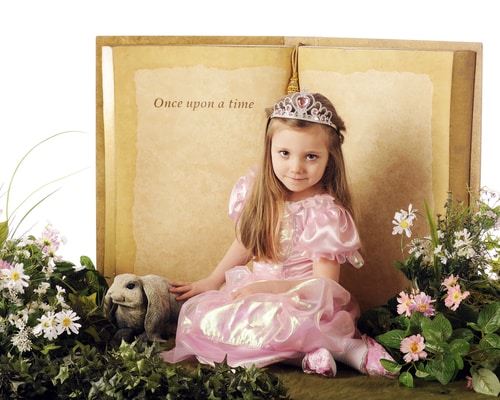Princess Play Vs. Princess Culture: There Is A Difference
 Princess play, the act of pretending one is a princess through dress up reenactment of fairy tales, took on a different connotation after a Disney executive attended an ice skating show in 2008. According to Peggy Orenstein‘s book Cinderella Ate My Daughter, the executive was stunned to see legions of little girls attending the show in homemade princess outfits. Because so many little girls were designing, or begging their parents to create, princess outfits, the trend was seen as a huge marketing opportunity for the company who the went on the market the princesses outside their respective fairy tales. It is because of this executive’s observation that we now have “princess culture” — the entire bubblegum wash of glitter, sparkles, rapid materialism, and cult-like following that Disney has no intentions of slowing down.
Princess play, the act of pretending one is a princess through dress up reenactment of fairy tales, took on a different connotation after a Disney executive attended an ice skating show in 2008. According to Peggy Orenstein‘s book Cinderella Ate My Daughter, the executive was stunned to see legions of little girls attending the show in homemade princess outfits. Because so many little girls were designing, or begging their parents to create, princess outfits, the trend was seen as a huge marketing opportunity for the company who the went on the market the princesses outside their respective fairy tales. It is because of this executive’s observation that we now have “princess culture” — the entire bubblegum wash of glitter, sparkles, rapid materialism, and cult-like following that Disney has no intentions of slowing down.
But the make-believe of being a princess or inhabiting a mythical story was not always a commercially-sanctioned past-time, and while there are many princess alternatives that Disney has not yet soiled, the current dilemma for parents is to parse out play-time for their princess-leaning children that is not being sold on television. Princess play, if coupled with other stories and fables, can be a powerful exercise for young girls who have interests beyond fainting and looking pretty. They may not have their own line of dresses and DVDs, but there are many accessible princesses who are known for more than their appearance — but rather engaging stories that highlight their skills and abilities.
Athena, although technically a goddess, was born to Queen Hera and Zeus in Greek mythology. Not only did Athena spring from her father’s head fully-formed (and fully adult), she was known to lead men into battles and was an excellent weaver. Her half-sister, Artemis, has been immortalized as an excellent archer with a penchant for animals and helping women in need. She also famously went after hunter who dared spy on her while she was bathing naked, turning him into stag.
Queen Elizabeth I of England and Ireland would also be princess worthy of your child’s imagination. Not only did Queen Elizabeth rule without a husband, prince, or a king, she is noted to have spoken six languages and have been a much more tactful leader than her father, restoring order to her kingdom. Cleopatra VII also seized control of her father’s empire with a top-notch education and a prowess for languages, philosophy, and literature.
In many ways, princess culture has adopted some of our most powerful women in history and diluted their stories to depict ether a strictly romantic plot or materialistic objectives. Mining history and myths for princesses who have gone unsullied by pink and plastic crowns can be a worthwhile effort to reframe princess ideology for girls — perhaps getting them to recognize the other traits that history’s most notable have possessed such as strength, tact, intelligence, and specific capabilities.
Princesses and queens are not innately problematic icons for girls. But our culture’s manipulation of the term and reappropriation has turned contemporary princess icons into mere fragments of their historical origins.
(photo: Glenda M. Powers/ Shutterstock)






